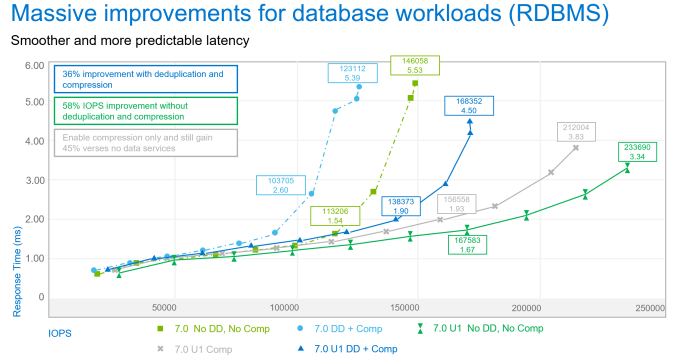Home > Integrated Products > VxRail > White Papers > Harnessing the Performance of Dell EMC VxRail 7.0.100—A Lab-Based Performance Analysis > Conclusion #3: vSAN compression-only is nearly penalty-free
Conclusion #3: vSAN compression-only is nearly penalty-free
-
The new compression-only feature has these significant benefits:
- Saves space while improving performance for compression-friendly workloads such as high-performance databases (that is, SAP and SQL).
- Stabilizes environments and reduces risk. By eliminating the deduplication requirement from the feature, users no longer have to worry that enabling better disk utilization will cause an entire disk group to fail if they lose just one drive.
Compression-only is a new and separate offering in vSAN 7.0 U1. Upgrading to vSAN 7.0 U1 provides database workloads with a performance boost of up to 58 percent while simultaneously unlocking the space-saving efficiencies of deduplication and compression.
The peak performance gains in vSAN 7.0 U1 are only part of the performance-improvement story. The following figure shows the performance curves with an RDBMS database workload using RAID 5. The best performance curves are long, flat lines. The further the curve is to the right, the higher the IOPS, and the flatter it is, the lower the latencies—both beneficial traits in storage performance. Overall, we can see that vSAN 7.0 U1 has performance gains, even when data services are used.

Figure 3. Workload simulation—RDBMS, RAID 5
Before reviewing the gains with data services, consider the gains without them. Comparing the two green lines in Figure 3, we can see that peak performance gained a significant 58 percent additional IOPS with just the vSAN upgrade. That increase in peak IOPS also came with a 39 percent reduction in latencies.
Regardless of the platform and service, there is always a trade-off between the benefit that a data service provides and the impact that it has. The trade-off tipping point varies from customer to customer, but with deduplication and compression on vSAN 7.0 U1, that tipping point has shifted significantly.
Comparing the two blue lines in Figure 3, we can see that peak performance with deduplication and compression enabled gained a significant 36 percent additional IOPS and reduced peak latency by more than 16 percent. Further, compare vSAN 7.0 U1 with deduplication and compression enabled (the solid blue line) and vSAN 7.0 without deduplication and compression enabled (the dashed green line). Even with deduplication and compression enabled, the IOPS gain was more than 15 percent, and the drop in latency was more than 18 percent. Not only can performance be gained, but so can additional capacity.
Finally, consider the gray line in Figure 3, which represents a new vSAN data service. In vSAN 7.0 U1, VMware has made compression available as a data reduction data service by itself, without deduplication. This data service enables demanding workloads (such as database workloads) to benefit from compression when they cannot take advantage of the space savings of deduplication. As compression-only did not exist in vSAN 7.0, we cannot show those gains. However, we can compare this latest release with and without compression-only enabled. Under vSAN 7.0 U1, enabling compression dropped peak IOPS a little more than 9 percent and increased latency a little more than 14 percent. For many, these levels of reduced peak IOPS and increased latency are a reasonable trade-off for the gains that compression can bring. The trade-off is especially justifiable for compression-friendly workloads such as large I/O block sizes in mixed workloads, RDBMS and OLTP databases, and VDI workloads using linked clones. If we compare vSAN 7.0 U1 with compression-only to vSAN 7.0 without data services, we still see a performance gain of 45 percent for peak IOPS with latencies dropping more than 30 percent.
If you are using deduplication on an early VxRail release, you might want to:
- Upgrade to the latest release.
- Disable deduplication.
- Enable compression-only to get between 50 and 70 percent more IOPS at lower latencies and a better failure scenario. For details, see the VMware blog Space Efficiency Using the New “Compression only” Option in vSAN 7 U1.
